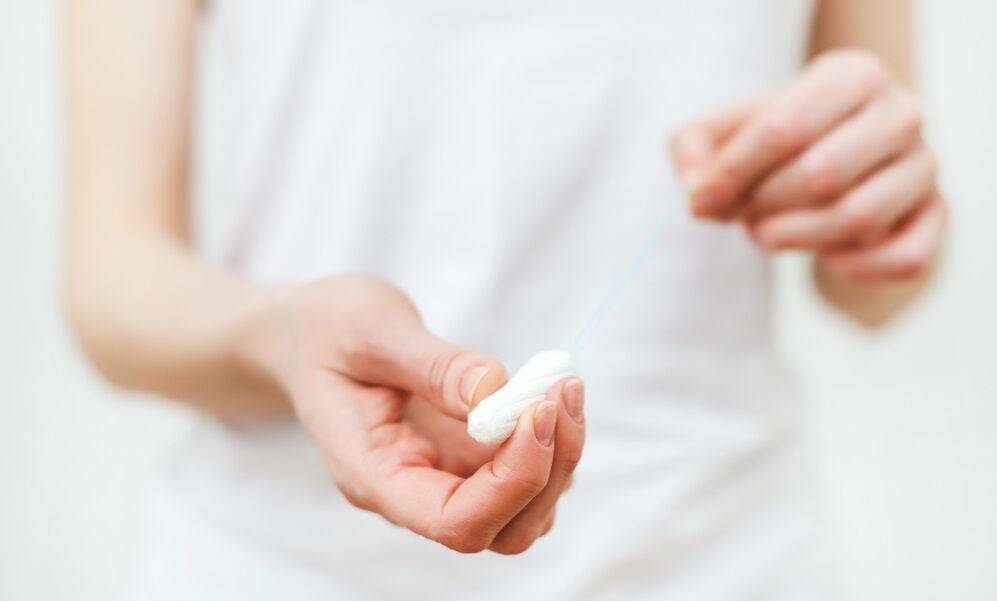Tampons are discreet, comfortable, convenient, and easy to carry in your purse or pocket. Around 70 percent of women prefer to use tampons as period protection products.
-
Tracking cycle
-
Getting pregnant
-
Pregnancy
-
Help Center
-
Flo for Partners
-
Anonymous Mode
-
Flo app reviews
-
Flo Premium New
-
Secret Chats New
-
Symptom Checker New
-
Your cycle
-
Health 360°
-
Getting pregnant
-
Pregnancy
-
Being a mom
-
LGBTQ+
-
Quizzes
-
Ovulation calculator
-
hCG calculator
-
Pregnancy test calculator
-
Menstrual cycle calculator
-
Period calculator
-
Implantation calculator
-
Pregnancy weeks to months calculator
-
Pregnancy due date calculator
-
IVF and FET due date calculator
-
Due date calculator by ultrasound
-
Medical Affairs
-
Science & Research
-
Pass It On Project New
-
Privacy Portal
-
Press Center
-
Flo Accuracy
-
Careers
-
Contact Us
Tampons Without Applicators: A How-To Guide


Every piece of content at Flo Health adheres to the highest editorial standards for language, style, and medical accuracy. To learn what we do to deliver the best health and lifestyle insights to you, check out our content review principles.
Non-applicator tampons are quickly gaining popularity. But do you know what their benefits are and how to use them? Read this article to learn more about tampons without applicators.
Tampons without applicators: what are they?
A tampon without an applicator is exactly the same as a traditional tampon. The only difference is that, as the name suggests, the tampon comes without cardboard or plastic applicator to insert it into your vagina.
Applicators are the small tubes used to insert the tampon and place it inside the vagina. Non-applicator tampons are exactly the same product; they simply come without that applicator. Like all tampons, the non-applicator variety allows you to carry out all your everyday activities, from exercising to swimming on your period.
Most tampon brands produce both kinds of tampons — with and without applicators. This is handy because you can try out tampons without applicators from a familiar brand and be assured of their quality.
How to insert a tampon without an applicator

Inserting a non-applicator tampon can take some getting used to. If you’ve been using applicator tampons for a while, it’s normal to need a few tries before you get the hang of how to put in a tampon without an applicator.
If you’re interested in trying out tampons without applicators, follow this step-by-step guide on how to insert them:
- The first step you need to follow each time you’re inserting a non-applicator tampon is to thoroughly wash your hands.
- Check the packaging of your tampon and make sure it doesn’t have any tears or holes. If it does, discard it and choose another one.
- Unwrap your non-applicator tampon. You’ll find the tampon string nestled against the tampon itself.
- Hold the string firmly and twist it a few times. Doing this will create an indentation in the bottom of the tampon — the perfect place to put your finger during application. It also ensures that the string will be placed correctly after you insert it.
- Sit on the toilet or stand up with one leg up. You can use a toilet or bathtub to support your foot in this position.
- Gently push the skin around your vaginal opening away with your free hand.
- Now get a firm hold on the tampon with your thumb and middle finger.
- Next, place your index finger in the small pocket you’ve created. Push the tampon inside your vagina, aiming it toward your lower back. Push it in until you reach the base of your finger. You won’t feel the tampon when it’s in the right place. If you do, push it a little further in.
- Make sure the string is left hanging outside of your body.
- Wash your hands, and you’re done!
This process might sound more complicated than inserting a regular tampon. However, you’ll get used to your non-applicator tampons after a few tries.
These are some of the most common mistakes to avoid while inserting a non-applicator tampon:
- Not inserting the tampon deep enough — It might feel strange to push the tampon in the entire length of your index finger. However, this is necessary to ensure that the tampon is placed correctly and to avoid any leaks. Don’t worry; the tampon won’t get lost inside your body if you push it too far. Your cervix serves as an anatomical stopper. If you’re worried that you haven’t inserted the tampon deep enough, you can always add a panty liner for backup.
- Using tampons with a higher absorbency than needed — Using large or jumbo tampons when you have a lighter flow can absorb your natural lubrication too quickly, making insertion uncomfortable. Using too-absorbent tampons can also increase your risk of developing toxic shock syndrome. Instead, use tampons with different levels of absorbency according to your flow on each day of your period.
- Forgetting to separate the string from the tampon before insertion. If the string isn’t left hanging outside of your body once you insert your tampon, you’ll have to retrieve it with your fingers when it’s time to remove it.
Take a quiz
Find out what you can do with our Health Assistant
Applicator vs. non-applicator tampons: which is better?
Although non-applicator tampons are less popular than traditional tampons in some parts of the world, the opposite is true in other areas.
The type of period protection product that you prefer is a very personal choice. Non-applicator tampons make some women feel like they have more control over the way they insert their tampons. Since tampon applicators are straight, they don’t mimic the natural curve of your vagina. Your fingers, however, can adapt to the shape of your vagina to provide a more comfortable application.
Non-applicator tampons are also preferred by many women who want to reduce the amount of waste that they produce. On average, a woman will use anywhere between 8,000 to 17,000 tampons during her lifetime. That’s a lot of applicators! These tiny plastic or cardboard tubes are later thrown in landfills and rarely recycled.
Tampons without applicators are a great way to reduce your environmental impact. There are other period products and methods that help with this too, such as menstrual cups and free bleeding. If you don’t want to switch to a menstrual cup but would still like to reduce your waste, non-applicator tampons could be the way to go.
At the end of the day, your favorite type of period protection product is a very intimate choice. There’s no right or wrong option; as long as you’re safe and healthy, it’s up to you to decide which product you’d like to use. If you’re interested in trying out tampons without applicators, know that it’s normal to need a few tries before you get the hang of the insertion process.
As long as you can wash your hands before and after inserting a non-applicator tampon, there’s nothing to be afraid or ashamed of. Periods are a normal part of human life, and there’s nothing wrong with using a non-applicator tampon. In fact, they could be just the right choice for you!


Hey, I'm Anique
I started using Flo app to track my period and ovulation because we wanted to have a baby.


The Flo app helped me learn about my body and spot ovulation signs during our conception journey.


I vividly
remember the day
that we switched
Flo into
Pregnancy Mode — it was
such a special
moment.
Real stories, real results
Learn how the Flo app became an amazing cheerleader for us on our conception journey.




